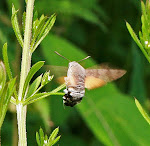In England, the Small Blue (Cupido minimus) is very scarce north of a line from the Severn/south Wales to the Wash. At one time it was thought to be extinct in Cumbria, not having been seen there for more than a decade until I had the good fortune to find a surviving colony at Maryport in early July 1983 (Entomologist's Record (1983) 95: 248-9). Since then, the colony seems to have thrived and additional populations have been found in the same general area.
.jpg)
.jpg)
As its name implies the butterfly is much smaller than other British blues with a wing span of about 20 mm. Their territories are very small, often only 20 metres or so in extent and only occur where their larval food-plant Kidney Vetch (Anthyllis vulneraria) is frequent.
.jpg)
.jpg)
Small Blues fly quickly and very close to the ground and this, together with their grey-blue colouration and small size, makes them difficult to follow. They especially favour small sheltered banks and depressions which are warmed by the sun. This particular population occupied perhaps a mere 25 metres long section of a steep sunny bank with much Kidney Vetch present. There were probably 15-20 butterflies flying here at the time, a few having become worn, although others appeared freshly emerged.
.jpg)
.jpg)
Here, the Small Blue flies from June to early July, the later ones probably resulting from a second brood. Eggs are laid individually onto separate flower heads and the larvae, which are cannabilistic, burrow into the calyxes and eat the seed. When fully developed they descend to ground level and, in a similar to those of the Large Blue, are thought to be attended by species of ants as they over-winter in soil crevices.
.jpg)
[The warm sunny bank, the habitat of this Small Blue colony]
Common Blues, Large Skippers and Meadow Browns were also flying here in the bright sunshine.
.jpg)






No comments:
Post a Comment